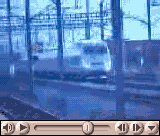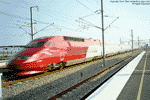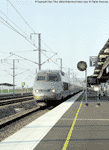
(394KB QuickTime 4 Movie)
|
Dan Ross tried this trip on 28 February 2000 and filmed the trains from
the platforms at TGV Haute-Picardie. The clip shows first a double trainset
passing in the direction of Paris, followed immediately by a northbound trainset.
Of course a compressed video like this does not come anywhere close to the
sight and sound of the real thing, but it does give a good preview. |
Sounds like fun? The following itinerary should make an interesting
excursion for TGV fans of all kinds, from the foreign tourist to the jaded
Parisian nervous wreck. From downtown Paris, the trip costs about 400FF
full fare return (or $80, less if you have a railpass) and can be done in
as little as three hours start to finish.
The Total TGV Trip
...which I suggest to you goes roughly like this:
- Start at Paris Gare du Nord, look at standing TGV trains
- Take RER to the Charles de Gaulle airport TGV station
- Take a TGV to the Haute-Picardie station
- Spend time watching TGVs speed by
- Return to CDG airport by TGV
- Return to downtown Paris by RER
The detour to the airport TGV station was necessary when I did this trip,
since none of the TGVs out of Paris Gare du Nord stopped at Haute Picardie
at the time. However, it appears that as of summer 1997 there exist a few
direct TGVs from Paris Nord to Haute Picardie-- Check the
schedules. It may still be easier to go via the airport.
Step One: Do a little planning with some TGV timetables. These
are available as guide booklets at all Paris stations, near the ticket
office. You want to get the timetables for the TGV Nord-Europe, Thalys,
and Eurostar. Thalys and Eurostar timetables are available
on the web. You will be leaving from Paris Aéroport Charles de
Gaulle TGV and arrive at TGV Haute-Picardie. Your train is a TGV
Nord-Europe, serving the Nord Pas de Calais from the Ile de France region.
Travel time is about 28 minutes but trains that stop at Haute-Picardie are
quite infrequent (only two per afternoon), so be careful with your timing.
Plan to stay there for about an hour; you'll probably get bored if you
stay longer, unless you're crazier than I. Once you have decided on your
arrangements to get to TGV Haute-Picardie, you can use the timetables to
estimate when trains will pass by. As a rule of thumb, the station is
about 32 minutes from Paris-Nord; use this fact to deduce your own
schedule of passing times at Haute-Picardie. This schedule will come in
handy once there, since you will first be able to see an oncoming train's
headlights only about 10 seconds before it reaches you. It's good to know
what's coming from what direction and when.
Step Two: I recommend starting from the Paris Gare du Nord
station, which is easily accessible by public transportation. You can
purchase your ticket here (about 290FF return, or $58, in second class)
and then go watch standing TGV trains from the station platforms. Paris
Nord, a busy station, has the most diverse TGV fauna to be found in Paris:
you will see Réseau and Thalys trainsets, and also Eurostar trainsets which are unfortunately isolated
behind glass walls.
Step Three: Go to the basement of the station to take the RER to
the Charles de Gaulle airport TGV station. The RER is not a TGV;
it is a suburban commuter train. Purchase your return trip to the airport
(about 92FF, or $18) and take the B3 line, direction Roissy /
Aéroport Charles de Gaulle. Trains are frequent, about every 15
minutes, and take you to the Charles de Gaulle 2 / TGV station, the end
stop of the line, in about 30 to 45 minutes. A few minutes out of Paris,
try to catch a glimpse of the Landy shops, to the left of the
train, one of the major TGV maintenance bases. Remember that CDG airport
has two RER stops; get off at the second. Once there, validate
your TGV ticket and transfer to the TGV platforms, where information
screens will tell you where to wait.
Step Four: Take your TGV up to the Haute-Picardie station... you
will be on the LGV (Ligne à Grand Vitesse, or high speed
line) Interconnexion for a few kilometers, and then connect to the LGV
Nord which goes all the way to Lille and the Channel tunnel. You'll ride
about 100 km, with a top speed of 300 km/h, and the trip will take 28
minutes. If you're new to the TGV, take this time to nose around and
explore.
Step Five: Hang out in the fields of Picardy... The west
(northbound) platforms are best for viewing in the afternoon; the
light is better for photography. It's usually pretty windy, so dress for
it. There are four tracks through the station; the center two are the
active high speed tracks. This puts a few meters between you and passing
trains, probably for the better. Platform clocks will give you the time,
and if you've done your schedule right you'll know where to look and what
type of train will go by next.
Step Six: Return to Paris by reversing the steps you took to
get here.
Also of Interest...
If you haven't had your fill of high speed action, take the Metro to
the La Villette science museum in Paris (line 7, Porte de La Villette).
In the basement there is a public library with video viewing stations
connected to a videotape server. Without charge you can view a large
selection of TGV-related videos covering a range of subjects from the
speed records to catenary design... This treasure trove is not to be
missed! Be advised however that they are all in French.
Feedback and Advice
Useful advice from several people who tried this trip and lived to
write about it!
Charles Spencer, March 1997:
The itinerary and suggestions were excellent in practice. In particular,
the advice to consult the timetable for stopping trains carefully so as
not to stay there too long was right on.
The only amendment I would make would be not to worry too much about
having schedules saying what trains would be coming through from
what directions. It's true that I was there on a very clear day, but I had
had some problem getting timetables at the Gare du Nord/Est; in any
event, I could see trains approaching Haute-Picardie a long way away
(in distance, not time!), and there were so many that I was well amused.
(Headway as little as 3-4 minutes on occasion.) I would add that this
trip is probably much more fruitful on a weekday (my experience), than
on a weekend day, judging by the schedules. A midday trip, with the
sun high, is also recommended. I was there from about noon to 1:30pm.
Bob Tomasko, May 1997:
I've ridden (the TGV) many times, but not until last week did I
stand on a platform as several passed at speed. What an experience! I
did this while overcoming jet lag and changing planes at CDG. The 10:54
departure from CDG and 13:08 return from HP worked very well.
You provided an excellent description of what to expect. The Thomas
Cook European schedules provided most of the information needed about
trains to and from Paris Nord.
I suggest TGV fans bring along their own beverages and food; the only
thing provided at the station was from vending machines.
Trevor Moss, July 1997:
I had something like 1 hour 40 mins on Haute Picardie which was
just a nice amount of time. I can see myself going back there again
sometime in the future, I enjoyed it so much. You are right in you what
you say about having to be quick with the camera !!. To film an oncoming
train I found I had to have my fingers on the camcorder buttons and be
on constant lookout all the time, in order not to miss the trains
approach.
Claudio Bellon, May 1998
Your suggestions are perfect for a day of train watching!
I had hoped to see the yellow mail trains, but had no luck. [Note:
the La Poste trainsets are not used on this line -CT]
The weather was lousy (about 9 or 10 Celsius and a windy drizzle), but
the show was superlative, with over 20 trains in 1-1/2 hours.
I was surprised to see heavy and continuous sparks on the pantographs,
but it is resonable when you consider the high voltage and
oscillation of the catenary.
I really enjoyed my day and heartily recommend this train watching
spot to anyone visiting Paris.
Nikolaus Rieskamp, January 1999
It is great out there, but it is useful to watch the weather on TV first.
I had a very foggy day wich made it impossible to observe a distance of more
than 200 meters. You hear the train shortly before you see it.
But if you know to handle that with your camera (you have to be faster than
Lucky Luke with his gun), you can make fantastic photos!
If you arrive at the wrong time, there may be no trains at all so reading timetables
first becomes very important!
If you have tried this trip, or if you have any suggestions, please
email me. All photos in
this page by C. Tillier
|

A Thalys PBA trainset passing at 300 km/h on the northbound
track, 03 September 96. Gotta be faster on that camera
button!
|

The 18:23 TGV to Rennes pulling up to the southbound
platform, 03 September 96
Last modified: April 2000
|
|
|